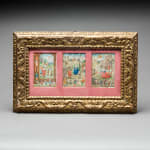Three Pages from an Illuminated Manuscript, 15th Century CE - 16th Century CE
Paint on Vellum
26 x 39.1 cm
10 1/4 x 15 3/8 in
10 1/4 x 15 3/8 in
X.0402
Further images
These three splendid full-page miniatures probably belonged to a Book of Hours which has since been dismantled. Books of Hours were used in private devotions and provided lay people with...
These three splendid full-page miniatures probably belonged to a Book of Hours which has since been dismantled. Books of Hours were used in private devotions and provided lay people with the opportunity to follow a shorter version of the prayers recited in the monasteries. By imitating the activity of the religious, men and women hoped to aid their own salvation. The three main scenes depicted were all common in this type of manuscript. The annunciation of the birth of Christ to the shepherds is often found at beginning of Terce, part of the Hours of the Virgin. The flight into Egypt is usually depicted at the start of Vespers. King David and his harp frequently make an appearance at the start of the Penitential Psalms as he is traditionally believed to be their author. One of the most remarkable features of these examples is the fact that the borders around the main images are fully illustrated with narrative scenes. They are also created using full colour not single tones. This was relatively unusual and is a measure of the care lavished upon them. Some of the subsidiary scenes depict actual Biblical events such as the massacre of the innocents. Others are more fanciful such as the band of peasants dancing beneath the annunciation to the shepherds. They were intended to delight the owner and provide a visual explanation of the accompanying text.
Although illuminated manuscripts were originally produced in monasteries, by the late fifteenth century specialised workshops fulfilled the same function. This period has been termed the ‘golden age’ of illumination. By this date the art was closely related to panel painting and the same artists often worked in both media. The figure of the godhead in the David illumination, for example, finds parallel in works by figures such as Hans Memling and Van Eyck. The style therefore suggests that they were created in northern Europe, possibly in a workshop in France or Flanders. The detailed landscapes and city views are particularly exquisite and recall these traditions. There was a vibrant export trade in these works which were sought after commodities in the leading European courts.
Illuminated manuscripts were the preserve of those with ample disposable income, partly because their production was so time-consuming. In contrast to printed alternatives the materials were also costly. The use of gold leaf on the framing devices confirms this. It has been deliberately placed over layers of red pigment so that it glows with an intense warmth. This type of gilding required immense skill and its secrets were closely guarded. Contemporary guild regulations stipulate that only the most qualified painters were allowed to practice it. The lively detail of the figures make these pages a visual feast and a window onto the religiosity of the late middle ages. (AM)
Although illuminated manuscripts were originally produced in monasteries, by the late fifteenth century specialised workshops fulfilled the same function. This period has been termed the ‘golden age’ of illumination. By this date the art was closely related to panel painting and the same artists often worked in both media. The figure of the godhead in the David illumination, for example, finds parallel in works by figures such as Hans Memling and Van Eyck. The style therefore suggests that they were created in northern Europe, possibly in a workshop in France or Flanders. The detailed landscapes and city views are particularly exquisite and recall these traditions. There was a vibrant export trade in these works which were sought after commodities in the leading European courts.
Illuminated manuscripts were the preserve of those with ample disposable income, partly because their production was so time-consuming. In contrast to printed alternatives the materials were also costly. The use of gold leaf on the framing devices confirms this. It has been deliberately placed over layers of red pigment so that it glows with an intense warmth. This type of gilding required immense skill and its secrets were closely guarded. Contemporary guild regulations stipulate that only the most qualified painters were allowed to practice it. The lively detail of the figures make these pages a visual feast and a window onto the religiosity of the late middle ages. (AM)













